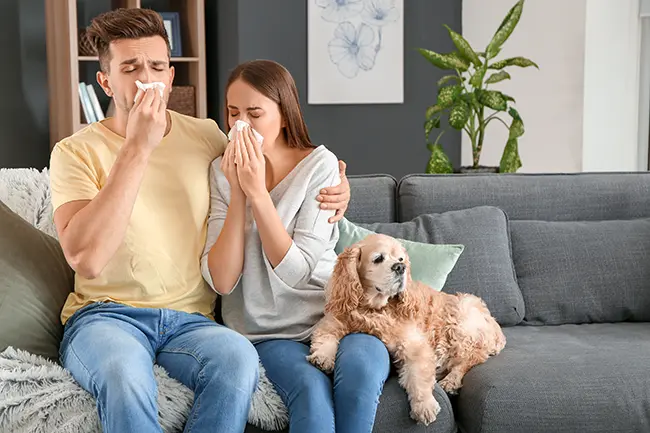
Many people can’t imagine life without their pets. Pets are confidants, playmates, and an essential part of the family. Yet pets are often culprits of allergic reactions.
About 10–20% of people globally are allergic to dogs and cats. Pets typically leave or carry allergens called dander. If you’ve ever found yourself with watery eyes, unending sneezing fits, or skin rashes, it could be due to these allergens.
Even well-groomed pets can be sources of allergens. But that doesn’t mean you get rid of your pet altogether. There are several workarounds to reduce pet dander in your home and have a healthier living space.
What is Pet Dander?
Pet dander refers to the tiny particles of dead skin cells, saliva, and other animal secretions. It is so small that it is often invisible to the naked eye. Most pets with fur or feathers—including cats, dogs, mice, and birds—produce dander.
Dander is made up of a specific type of protein that can trigger an allergic reaction in some people. Even a small amount can trigger symptoms if you’re sensitive to such allergens.
What Pets Shed the Most Dander?
Pets shed off varying amounts of dander. Cats and dogs are the most popular household pets. Cat dander is said to be more allergenic than dog dander. Animals that produce less dander are labeled hypoallergenic.
Lesser shedding dogs include poodle, basenji, bichon frise, Havanese, Irish water spaniel, Kerry blue terrier, and Bedlington terrier.
Devon rex, Bengal, sphynx, Russian blue, Javanese, Cornish, and Siberian cats are hypoallergenic.
Just note that no pet is 100% allergen-free.
Besides cats and dogs, birds and rodents produce dander too. Birds usually shed tiny skin particles from their feathers, whereas wild and pet rodents accumulate dander in their urine or saliva.
A common misconception is that hairless or short-haired pets are often hypoallergenic. That isn’t true. It’s never about the hair length but the protein amount in the dander. A bit of research before buying your next pet may save you from developing allergies.
Symptoms of Pet Dander Allergies

Knowing typical signs of pet dander allergies can help you spring into action quickly. The most common reactions are sneezing and watery eyes. Sometimes, skin rashes may appear, or you may run short of breath.
Prolonged exposure may lead to chronic respiratory problems, like asthma, bronchitis, and chronic obstructive pulmonary disease (COPD). These conditions can make breathing challenging, reducing your quality of life. Thus, taking prompt action to make your home dander-free is essential.
How to Minimize Dander
Countering pet dander in your home isn’t overly complicated. Below are actionable tips you can apply right away:
- Regular pet grooming: Thoroughly brush and bathe your pet, preferably after every three months. It makes your pet look great while minimizing the spread of dander in your house.
- Deep cleaning: Deep-clean your home at least weekly. It helps rid your home of pet dander and other allergens like dust and pollen. You’d want to use high-efficiency particulate air (HEPA) vacuum cleaners, whose filters trap extremely small, micron-sized particles. Make sure you thoroughly clean your carpets, pet beds, upholstery, air ducts, curtains, and corners, which can harbor large amounts of dander.
- Designate allergen-free zones: You can restrict your pets from accessing certain rooms in your home. These will act as your sanctuary where you can retreat to whenever the symptoms flare up.
- Remove your carpet: Carpets trap large amounts of dander and hide it in spots that vacuum cleaners can’t reach. You could consider replacing your carpet with better alternatives like hardwood, laminate, or tiles. These are easy to clean and don’t trap allergens. They’re also stylish, so you’re not sacrificing beauty. For underfoot warmth, you can use smaller rugs.
There’s no shortcut to an allergen-free home. You must be up to speed with your cleaning.
When to Seek Professional Help
Do-it-yourself approaches usually suffice, but there are times you may need expert help, as outlined below:
- Severe allergic reactions: Allergic symptoms like sneezing and rashes can range from mild to severe. If you don’t notice improvement even after ridding your house of allergens and taking some over-the-counter medication, consider contacting a professional. There may be underlying issues unknown to you.
- Allergy tests: You may blame your pet for your allergies, but sometimes they may be innocent. It might be you’re reacting to the pollen or dust they carry in their fur from outside. Thus, it’s critical to go for allergy tests to know the root cause of the issue. These tests help identify the specific allergens causing the reactions. With this knowledge, you can better manage your home environment.
- Tailored treatment: Over-the-counter antihistamines can provide immediate relief to some allergy symptoms. But you can’t depend on these if your reactions are severe. You need experts to diagnose your condition accurately and administer appropriate allergy shots.
All in all, never brush off persistent allergy symptoms. Seek help from your doctor for help.
Conclusion
Pets play a significant role in human life. They offer joy, comfort, and genuine companionship. However, their presence in homes comes with the hidden danger of dander.
While removing the pet from your home could be the best solution, it may not be practical because of the existing bond. So use strategies like deep cleaning and designating pet-free zones in your home.
Moreover, never hesitate to consult professionals for a more lasting solution. The solution to a healthier home is in your hands.



